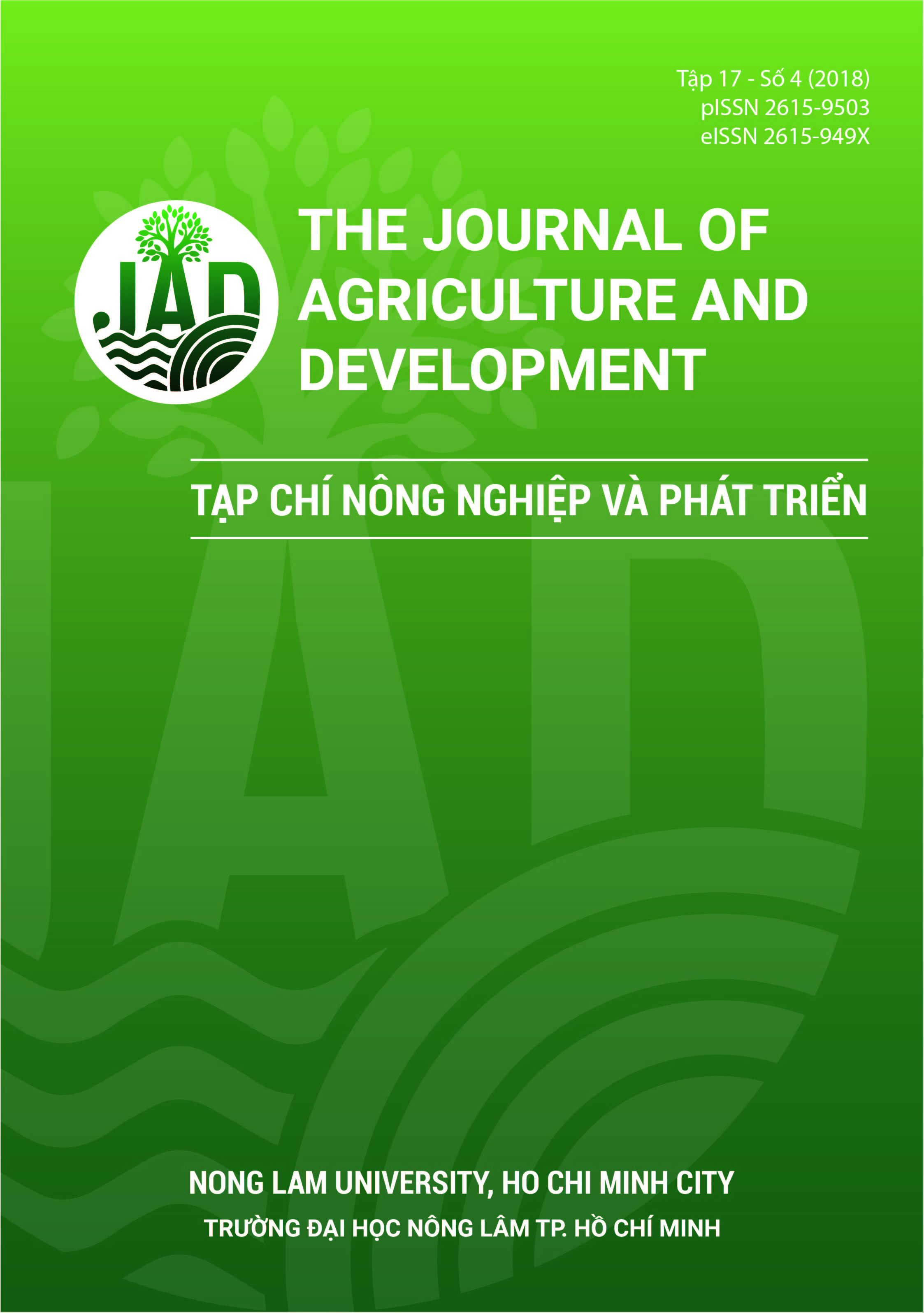Xác định một số điều kiện thích hợp cảm ứng tạo rễ tóc đậu nành sử dụng vi khuẩn Agrobacterium rhizogenes
Main Article Content
Tóm tắt
Nghiên cứu nhằm xác định một số điều kiện thích hợp cho chuyển gen bằng vi khuẩn Agrobacterium rhizogenes ở hai giống đậu nành HLĐN29 và DT84. Ở cả hai giống đậu nành, mẫu lá mầm cảm ứng tạo rễ tốt hơn so với trụ hạ diệp. Ở giống đậu nành HLĐN29, 96 - 100% mẫu tạo rễ khi lây nhiễm với chủng vi khuẩn ATCC11325 và ATCC15834, số rễ trung bình khoảng 8 rễ/mẫu. Đối với giống đậu nành DT84, chỉ có chủng vi khuẩn ATCC15834 cho hiệu quả tạo rễ tốt nhất. Sử dụng lá mầm đậu nành 6 - 8 ngày sau khi gieo cho hiệu quả tạo rễ tốt nhất và thuận tiện trong thao tác. Hai cách lây nhiễm trực tiếp và ngâm mẫu cho tỉ lệ mẫu tạo rễ và số rễ trung bình tương đương nhau trên cả hai giống đậu nành HLĐN29 và DT84. Rễ chuyển gen được xác định thông qua phân tích PCR sử dụng cặp primer đặc hiệu cho gen virD và rolC.
Article Details
Tài liệu tham khảo
AL-Yozbaki, G. S. H., Rasheed, J. H., & Salih, S. M. (2015). Transformation of Soybean (Glycine max L.) Via GUS-Labeled Agrobacterium rhizogenes R1000. International Journal of Science and Technology 4(6), 267-272.
Cao, D., Hou, W., Song, S., Sun, H., Wu, C., Gao, Y., & Han, T. (2009). Assessment of conditions affecting Agrobacterium rhizogenes mediated transformation of soybean. Plant Cell, Tissue and Organ Culture 96(1), 45-52. https://doi.org/10.1007/s11240-008-9458-x
Cho, H. J., Farrand, S. K., Noel, G. R., & Widholm, J. M. (2000). High-efficiency induction of soybean hairy roots and propagation of the soybean cyst nematode. Planta 210(2), 195-204. https://doi.org/10.1007/PL00008126
Collier, R., Fuchs, B., Walter, N., Kevin, L. W., & Taylor, C. G. (2005). Ex vitro composite plants: An inexpensive, rapid method for root biology. The Plant Journal 43(3), 449-457. https://doi.org/10.1111/j.1365-313X.2005.02454.x
Fattahi, M., Nazeri V., Torras-Claveria, L., Sefidkon, F., Cusido, R. M., Zamani, Z., & Palazon, J. (2013). A new biotechnological source of rosmarinic acid and surface flavonoids: hairy root cultures of Dracocephalum kotschyi Boiss. Industrial Crops and Products 50, 256-263. https://doi.org/10.1016/j.indcrop.2013.07.029
Gamborg, O. L., Miller, R. A., & Ojima, K.(1968). Nutrient requirement of suspensions cultures of soybean root cells. Experimental Cell Research 50(1), 151-158. https://doi.org/10.1016/0014-4827(68)90403-5
Hayashi, T., Banba, M., Shimoda, Y., Kouchi, H., Hayashi, M., & Imaizumi-Anraku, H. (2010). A dominant function of CCaMK in intracellular accommodation of bacterial and fungal endosymbionts. The Plant Journal 63(1), 141-154. https://doi.org/10.1111/j.1365-313X.2010.04228.x
Hernandez-Garcia, C. M., Bouchard, R. A., Rushton, P. J., Jones, M. L., Chen, X., Timko, M. P., & Finer, J. J. (2010). High level transgenic expression of soybean (Glycine max) GmERF and GmUBI gene promoters isolated by a novel promoter analysis pipeline. BMC Plant Biology 10(1), 237. https://doi.org/10.1186/1471-2229-10-237
Homrich, M. S., Wiebke-Strohm, B., Weber, R. L. M., & Bodanese-Zanettini, M. H. (2012). Soybean genetic transformation: A valuable tool for the functional study of genes and the production of agronomically improved plants. Genetics and Molecular Biology 35(4), 998-1010.
ISAAA (International Service for The Acquisition of Agro-Biotech Applications). 2016. Global Status of Commercialized Biotech/GM Crops: 2016. New York, USA: ISAAA.
Karmarkar, S. H, Keshavachandran, R., Nazeem, P. A., & Girija, D. (2001). Hairy root induction in Adapathiyan (Holostemma adakodien K. Schum.). Journal of Tropical Agriculture 39(12), 102-107.
Kereszt, A., Li, D., Indrasumunar, A., Nguyen, C. D. T, Nontachaiyapoom, S., Kinkema, M., & Gresshoff, P. M. (2007). Agrobacterium rhizogenes mediated transformation of soybean to study root biology. Nature protocols 2(4), 948-952. https://doi.org/10.1038/nprot.2007.141
Krishnan, H. B. (2005). Engineering Soybean for Enhanced Sulfur Amino Acid Content. Crop Science 45(2), 454-461. https://doi.org/10.2135/cropsci2005.0454
Li, J., Todd, T. C., & Trick, H. N. (2010). Rapid in planta evaluation of root expressed transgenes in chimeric soybean plants. Plant Cell Reports 29(2), 113-123. https://doi.org/10.1007/s00299-009-0803-2
Marcolino-Gomes, J., Rodrigues, F. A., Fuganti-Pagliarini, R., Nakayama, T. J., Ribeiro Reis, R., Bou ̧cas Farias, J. R., Harmon, F. G., Molinari, H. B. C., Molinari, M. D. C., & Nepomuceno, A. (2015). Transcriptome-wide identification of reference genes for expression analysis of soybean responses to drought stress along the day. Plos one 10(9), e013905. https://doi.org/10.1371/journal.pone.0139051
Olhoft, P. M., Bernal, L. M., Grist, L. B., Hill, D. S., Mankin, S. L., Shen, Y., Kalogerakis, M., Wiley, H., Toren, E., Song, H. S., Hillebrand, H., & Jones, T. (2007). A novel Agrobacterium rhizogenes -mediated transformation method of soybean [Glycine max (L.) Merrill] using primary-node explants from seedlings. In Vitro Cellular & Developmental Biology - Plant 43(6), 536-549. https://doi.org/10.1007/s11627-007-9050-9
Olhoft, P. M., Flagel, L. E., Donovan, C. M., & Somers, D. A. (2003). Efficient soybean transformation using hygromycin B selection in the cotyledonary-node method. Planta 216(5), 723-735. https://doi.org/10.1007/s00425-002-0922-2
Ozyigit, I. I., Dogan, I., & Artam Tarhan, E. (2013). Agrobacterium rhizogenes-Mediated Transformation and Its Biotechnological Applications in Crops. In Hakeem, K. R., Ahmad, P., & Ozturk, M. (Eds.). Crop Improvement: New Approaches and Modern Techniques (ed., 1-48). Massachusetts, USA: Springer.
Savka, M. A., Ravillion, B., Noel, G. R., & Farrand, S. K. (1990). Induction of hairy root on cultivated soybean genoptypes and their use to propagate soybean cyst nematode. Phytopathology 80(5), 503- 508.
Subramanian, A., Tamayo, P., Mootha, V. K., Mukherjee, S., Ebert, B. L., Gillette, M. A., Paulovich, A., Pomeroy, S. L., Golub, T. R., Lander, E. S., & Mesirov, J. P. (2005). Gene set enrichment analysis: A knowledge-based approach for interpreting genome-wide expression profiles. Proceedings of the National Academy of Sciences 102(43), 15545-15550. https://doi.org/10.1073/pnas.0506580102
Tazeen, S., & Mirza, B. (2004). Factors affecting Agrobacterium tumefaciens mediated genetic transformation of Vigna radiata (L.). Pakistan journal of botany 36(4), 887-896.
Tran, D. V. (2007). Soybean Glycine max (L) Merr. Ha Noi, Vietnam: Agricultural Publishing House.








